HNN215 Quality Use of Medicines Case Study: Nursing Medication Risks
VerifiedAdded on 2022/09/22
|9
|2585
|16
Case Study
AI Summary
This case study presents a nursing scenario involving a 56-year-old female patient, Ms. Candice Tong, admitted to the hospital with upper abdominal pain, nausea, and vomiting, diagnosed with peptic ulcers caused by Helicobacter pylori. The case study explores potential drug interactions and risks associated with Ms. Tong's prescribed medications, including Citalopram, Atorvastatin, Ramipril, Felodipine, clarithromycin, esomeprazole, and amoxicillin. It identifies significant risks like internal bleeding, kidney complications, and cardiovascular issues due to drug-drug interactions. The study then proposes nursing interventions to prevent and manage these risks, such as assessing drug dosages, monitoring INR levels, consulting with physicians, and educating the patient about potential side effects and over-the-counter medication interactions like Ibuprofen and St. John's wort. The case study emphasizes the importance of patient education, including medication labels, dose timing, and the need for regular medical history reviews to ensure patient safety and effective medication management. References supporting the findings are included.
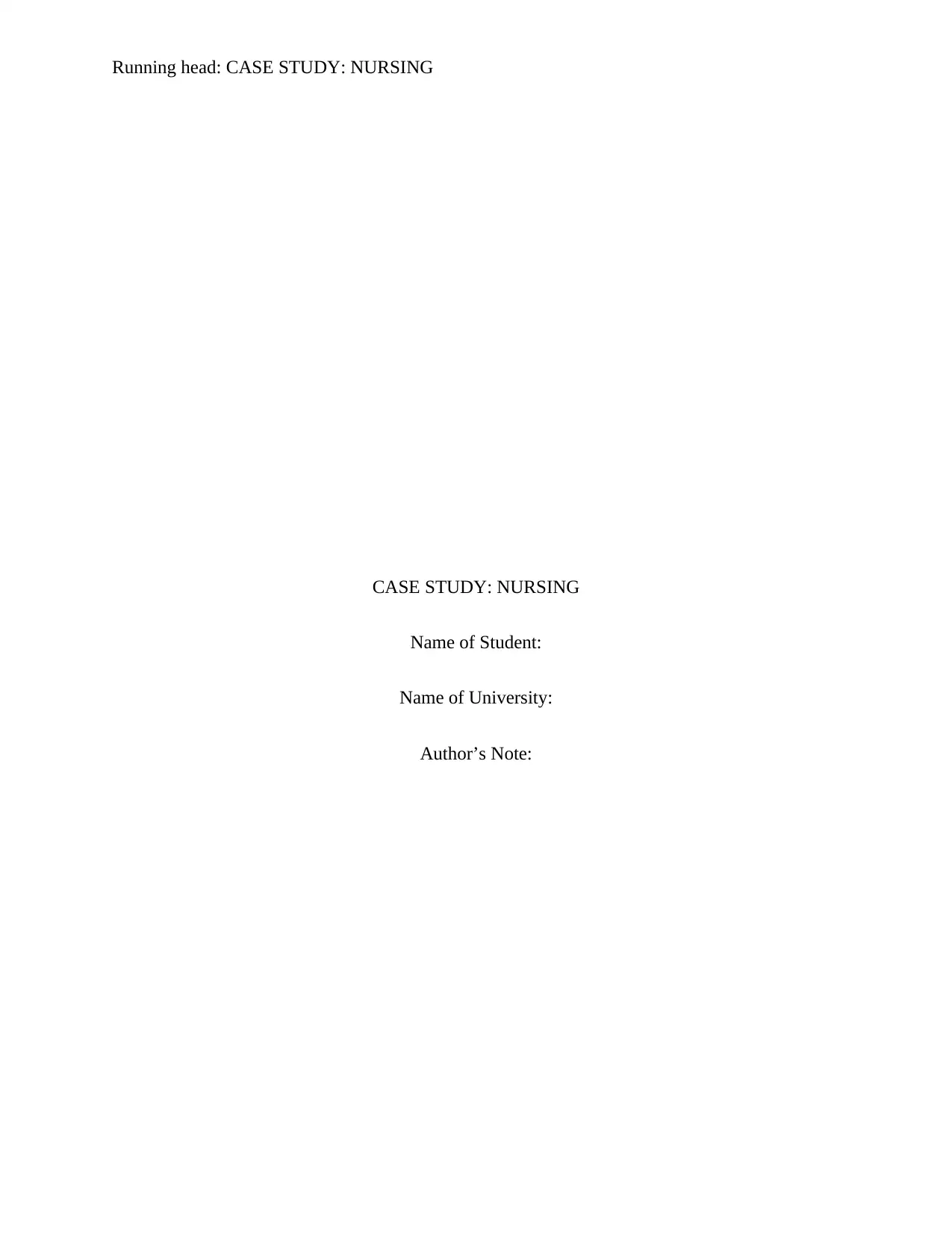
Running head: CASE STUDY: NURSING
CASE STUDY: NURSING
Name of Student:
Name of University:
Author’s Note:
CASE STUDY: NURSING
Name of Student:
Name of University:
Author’s Note:
Paraphrase This Document
Need a fresh take? Get an instant paraphrase of this document with our AI Paraphraser

1CASE STUDY: NURSING
Answer number 1.
The significant risk that is linked with the medication for Mr Tong:
The patient, MS Canadice Tong, is of 56 years old who was admitted to the hospital for
complaint of upper abdominal pain, vomiting and nausea. On assessment, she was diagnosed
with the peptic ulcer, which was infected by the Helicobacter pylori bacteria. As the mean of
treatment, she was given pharmacology intervention and prescribed medicine was Citalopram for
the depression, Atorvastatin for high cholesterol, Ramipril and Felodipine for high blood
pressure. Further, for treating ulcer, she was advised with clarithromycin, and esomeprazole and
amoxicillin medicine. From the review of the medication chart, and evaluating the side effect of
the drugs given, drug-drug interaction was noticed which is the primary reason for the side
effects, the two main risk that has been recognized for Ms Tong are as follow:
1. It is evident from the medication chart that Citalopram, Atorvastatin, Ramipril and
Felodipine are needed to be taken daily where they may interact with the antibiotic,
halting their action. For the treatment of ulcer the antibiotic amoxicillin, and
esomeprazole is prescribed, which have a negative impact on the patient because she is
also taking Ramipril. Atorvastatin is HMG CoA reductase inhibitors, which is interrupted
in its action by antibiotic along with the action of Ramipril (Nayan et al., 2017). It is
evident from the study of Surichan et al. (2018) that Atorvastatin action is altered by
inhibiting the activity of the cytochrome P450 due to which it loses its function of
clotting blood. It is also evident from the study of Psaty and Cooper (2018) that drugs for
hypertension and anticoagulant medicine along with antibiotic may cause harmful
consequence to the patient. As an impact of such, Ms Tong may have internal bleeding
Answer number 1.
The significant risk that is linked with the medication for Mr Tong:
The patient, MS Canadice Tong, is of 56 years old who was admitted to the hospital for
complaint of upper abdominal pain, vomiting and nausea. On assessment, she was diagnosed
with the peptic ulcer, which was infected by the Helicobacter pylori bacteria. As the mean of
treatment, she was given pharmacology intervention and prescribed medicine was Citalopram for
the depression, Atorvastatin for high cholesterol, Ramipril and Felodipine for high blood
pressure. Further, for treating ulcer, she was advised with clarithromycin, and esomeprazole and
amoxicillin medicine. From the review of the medication chart, and evaluating the side effect of
the drugs given, drug-drug interaction was noticed which is the primary reason for the side
effects, the two main risk that has been recognized for Ms Tong are as follow:
1. It is evident from the medication chart that Citalopram, Atorvastatin, Ramipril and
Felodipine are needed to be taken daily where they may interact with the antibiotic,
halting their action. For the treatment of ulcer the antibiotic amoxicillin, and
esomeprazole is prescribed, which have a negative impact on the patient because she is
also taking Ramipril. Atorvastatin is HMG CoA reductase inhibitors, which is interrupted
in its action by antibiotic along with the action of Ramipril (Nayan et al., 2017). It is
evident from the study of Surichan et al. (2018) that Atorvastatin action is altered by
inhibiting the activity of the cytochrome P450 due to which it loses its function of
clotting blood. It is also evident from the study of Psaty and Cooper (2018) that drugs for
hypertension and anticoagulant medicine along with antibiotic may cause harmful
consequence to the patient. As an impact of such, Ms Tong may have internal bleeding
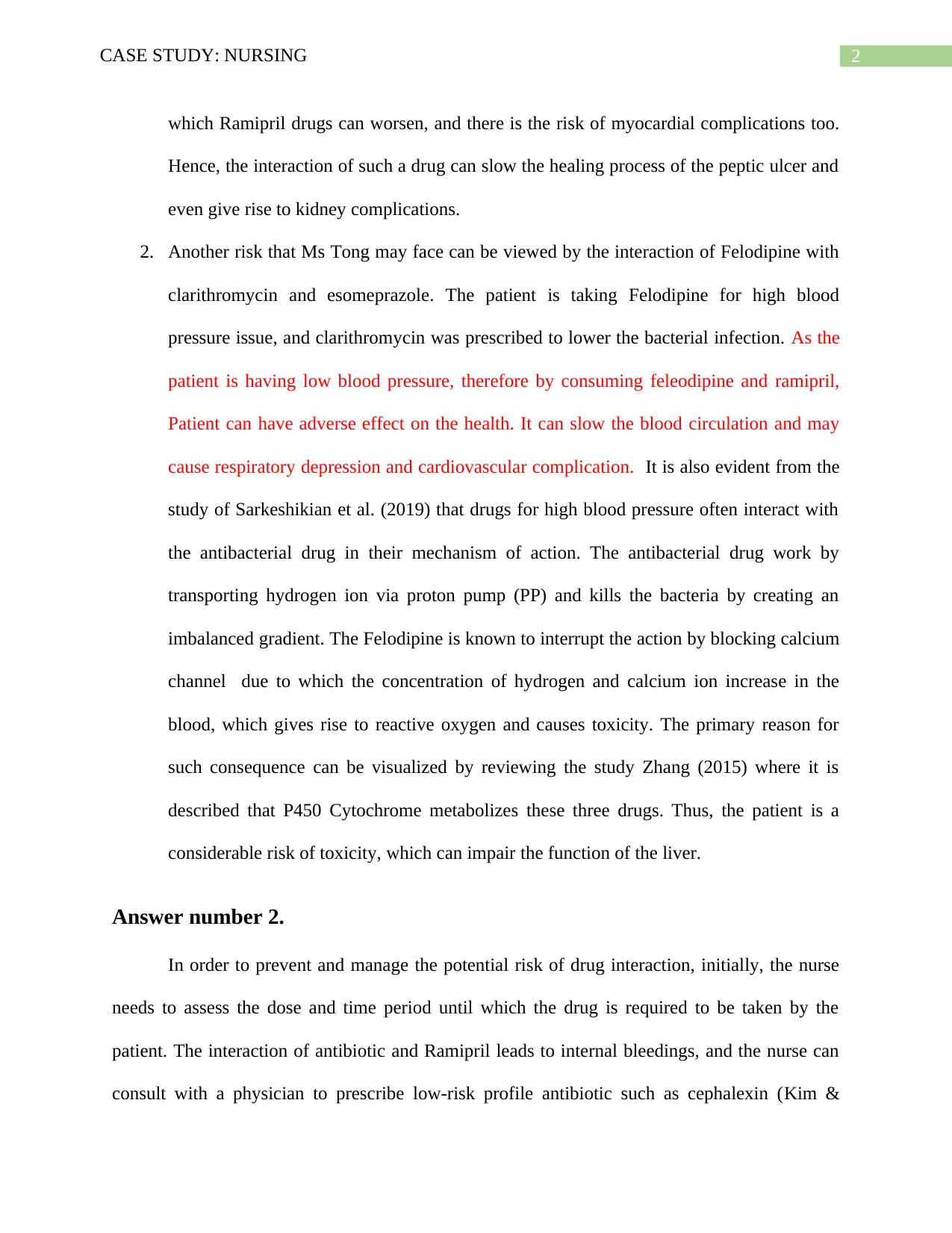
2CASE STUDY: NURSING
which Ramipril drugs can worsen, and there is the risk of myocardial complications too.
Hence, the interaction of such a drug can slow the healing process of the peptic ulcer and
even give rise to kidney complications.
2. Another risk that Ms Tong may face can be viewed by the interaction of Felodipine with
clarithromycin and esomeprazole. The patient is taking Felodipine for high blood
pressure issue, and clarithromycin was prescribed to lower the bacterial infection. As the
patient is having low blood pressure, therefore by consuming feleodipine and ramipril,
Patient can have adverse effect on the health. It can slow the blood circulation and may
cause respiratory depression and cardiovascular complication. It is also evident from the
study of Sarkeshikian et al. (2019) that drugs for high blood pressure often interact with
the antibacterial drug in their mechanism of action. The antibacterial drug work by
transporting hydrogen ion via proton pump (PP) and kills the bacteria by creating an
imbalanced gradient. The Felodipine is known to interrupt the action by blocking calcium
channel due to which the concentration of hydrogen and calcium ion increase in the
blood, which gives rise to reactive oxygen and causes toxicity. The primary reason for
such consequence can be visualized by reviewing the study Zhang (2015) where it is
described that P450 Cytochrome metabolizes these three drugs. Thus, the patient is a
considerable risk of toxicity, which can impair the function of the liver.
Answer number 2.
In order to prevent and manage the potential risk of drug interaction, initially, the nurse
needs to assess the dose and time period until which the drug is required to be taken by the
patient. The interaction of antibiotic and Ramipril leads to internal bleedings, and the nurse can
consult with a physician to prescribe low-risk profile antibiotic such as cephalexin (Kim &
which Ramipril drugs can worsen, and there is the risk of myocardial complications too.
Hence, the interaction of such a drug can slow the healing process of the peptic ulcer and
even give rise to kidney complications.
2. Another risk that Ms Tong may face can be viewed by the interaction of Felodipine with
clarithromycin and esomeprazole. The patient is taking Felodipine for high blood
pressure issue, and clarithromycin was prescribed to lower the bacterial infection. As the
patient is having low blood pressure, therefore by consuming feleodipine and ramipril,
Patient can have adverse effect on the health. It can slow the blood circulation and may
cause respiratory depression and cardiovascular complication. It is also evident from the
study of Sarkeshikian et al. (2019) that drugs for high blood pressure often interact with
the antibacterial drug in their mechanism of action. The antibacterial drug work by
transporting hydrogen ion via proton pump (PP) and kills the bacteria by creating an
imbalanced gradient. The Felodipine is known to interrupt the action by blocking calcium
channel due to which the concentration of hydrogen and calcium ion increase in the
blood, which gives rise to reactive oxygen and causes toxicity. The primary reason for
such consequence can be visualized by reviewing the study Zhang (2015) where it is
described that P450 Cytochrome metabolizes these three drugs. Thus, the patient is a
considerable risk of toxicity, which can impair the function of the liver.
Answer number 2.
In order to prevent and manage the potential risk of drug interaction, initially, the nurse
needs to assess the dose and time period until which the drug is required to be taken by the
patient. The interaction of antibiotic and Ramipril leads to internal bleedings, and the nurse can
consult with a physician to prescribe low-risk profile antibiotic such as cephalexin (Kim &
⊘ This is a preview!⊘
Do you want full access?
Subscribe today to unlock all pages.

Trusted by 1+ million students worldwide
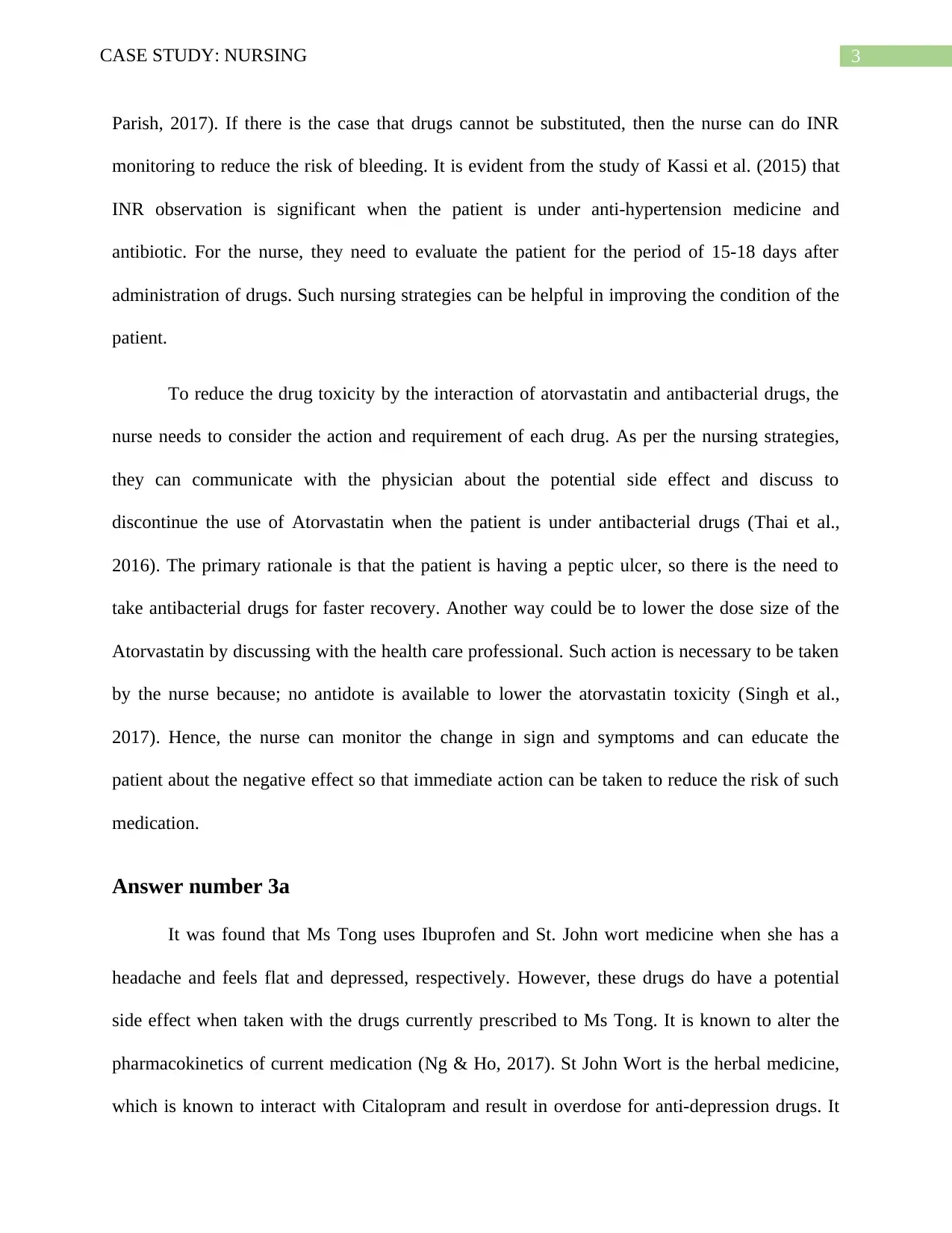
3CASE STUDY: NURSING
Parish, 2017). If there is the case that drugs cannot be substituted, then the nurse can do INR
monitoring to reduce the risk of bleeding. It is evident from the study of Kassi et al. (2015) that
INR observation is significant when the patient is under anti-hypertension medicine and
antibiotic. For the nurse, they need to evaluate the patient for the period of 15-18 days after
administration of drugs. Such nursing strategies can be helpful in improving the condition of the
patient.
To reduce the drug toxicity by the interaction of atorvastatin and antibacterial drugs, the
nurse needs to consider the action and requirement of each drug. As per the nursing strategies,
they can communicate with the physician about the potential side effect and discuss to
discontinue the use of Atorvastatin when the patient is under antibacterial drugs (Thai et al.,
2016). The primary rationale is that the patient is having a peptic ulcer, so there is the need to
take antibacterial drugs for faster recovery. Another way could be to lower the dose size of the
Atorvastatin by discussing with the health care professional. Such action is necessary to be taken
by the nurse because; no antidote is available to lower the atorvastatin toxicity (Singh et al.,
2017). Hence, the nurse can monitor the change in sign and symptoms and can educate the
patient about the negative effect so that immediate action can be taken to reduce the risk of such
medication.
Answer number 3a
It was found that Ms Tong uses Ibuprofen and St. John wort medicine when she has a
headache and feels flat and depressed, respectively. However, these drugs do have a potential
side effect when taken with the drugs currently prescribed to Ms Tong. It is known to alter the
pharmacokinetics of current medication (Ng & Ho, 2017). St John Wort is the herbal medicine,
which is known to interact with Citalopram and result in overdose for anti-depression drugs. It
Parish, 2017). If there is the case that drugs cannot be substituted, then the nurse can do INR
monitoring to reduce the risk of bleeding. It is evident from the study of Kassi et al. (2015) that
INR observation is significant when the patient is under anti-hypertension medicine and
antibiotic. For the nurse, they need to evaluate the patient for the period of 15-18 days after
administration of drugs. Such nursing strategies can be helpful in improving the condition of the
patient.
To reduce the drug toxicity by the interaction of atorvastatin and antibacterial drugs, the
nurse needs to consider the action and requirement of each drug. As per the nursing strategies,
they can communicate with the physician about the potential side effect and discuss to
discontinue the use of Atorvastatin when the patient is under antibacterial drugs (Thai et al.,
2016). The primary rationale is that the patient is having a peptic ulcer, so there is the need to
take antibacterial drugs for faster recovery. Another way could be to lower the dose size of the
Atorvastatin by discussing with the health care professional. Such action is necessary to be taken
by the nurse because; no antidote is available to lower the atorvastatin toxicity (Singh et al.,
2017). Hence, the nurse can monitor the change in sign and symptoms and can educate the
patient about the negative effect so that immediate action can be taken to reduce the risk of such
medication.
Answer number 3a
It was found that Ms Tong uses Ibuprofen and St. John wort medicine when she has a
headache and feels flat and depressed, respectively. However, these drugs do have a potential
side effect when taken with the drugs currently prescribed to Ms Tong. It is known to alter the
pharmacokinetics of current medication (Ng & Ho, 2017). St John Wort is the herbal medicine,
which is known to interact with Citalopram and result in overdose for anti-depression drugs. It
Paraphrase This Document
Need a fresh take? Get an instant paraphrase of this document with our AI Paraphraser
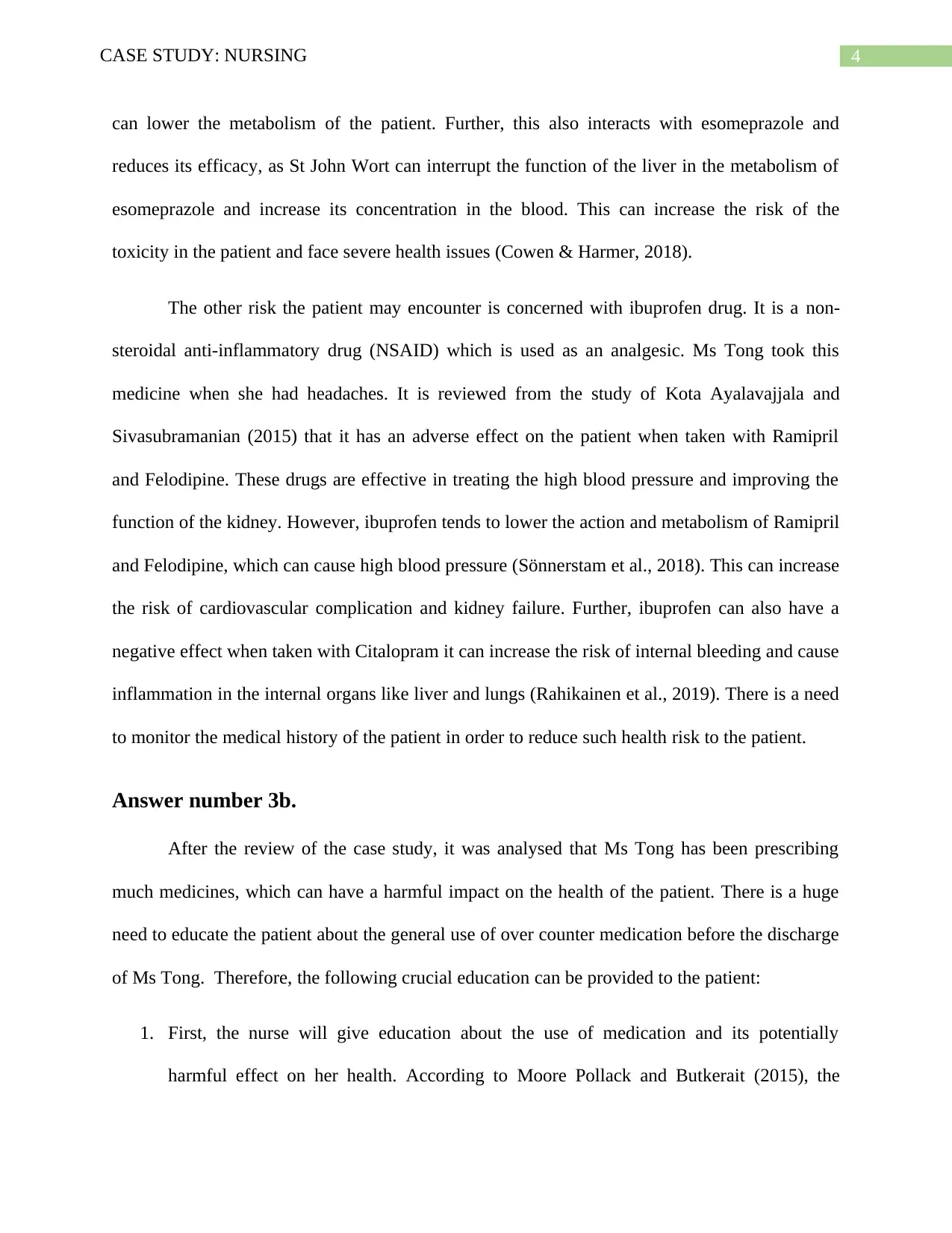
4CASE STUDY: NURSING
can lower the metabolism of the patient. Further, this also interacts with esomeprazole and
reduces its efficacy, as St John Wort can interrupt the function of the liver in the metabolism of
esomeprazole and increase its concentration in the blood. This can increase the risk of the
toxicity in the patient and face severe health issues (Cowen & Harmer, 2018).
The other risk the patient may encounter is concerned with ibuprofen drug. It is a non-
steroidal anti-inflammatory drug (NSAID) which is used as an analgesic. Ms Tong took this
medicine when she had headaches. It is reviewed from the study of Kota Ayalavajjala and
Sivasubramanian (2015) that it has an adverse effect on the patient when taken with Ramipril
and Felodipine. These drugs are effective in treating the high blood pressure and improving the
function of the kidney. However, ibuprofen tends to lower the action and metabolism of Ramipril
and Felodipine, which can cause high blood pressure (Sönnerstam et al., 2018). This can increase
the risk of cardiovascular complication and kidney failure. Further, ibuprofen can also have a
negative effect when taken with Citalopram it can increase the risk of internal bleeding and cause
inflammation in the internal organs like liver and lungs (Rahikainen et al., 2019). There is a need
to monitor the medical history of the patient in order to reduce such health risk to the patient.
Answer number 3b.
After the review of the case study, it was analysed that Ms Tong has been prescribing
much medicines, which can have a harmful impact on the health of the patient. There is a huge
need to educate the patient about the general use of over counter medication before the discharge
of Ms Tong. Therefore, the following crucial education can be provided to the patient:
1. First, the nurse will give education about the use of medication and its potentially
harmful effect on her health. According to Moore Pollack and Butkerait (2015), the
can lower the metabolism of the patient. Further, this also interacts with esomeprazole and
reduces its efficacy, as St John Wort can interrupt the function of the liver in the metabolism of
esomeprazole and increase its concentration in the blood. This can increase the risk of the
toxicity in the patient and face severe health issues (Cowen & Harmer, 2018).
The other risk the patient may encounter is concerned with ibuprofen drug. It is a non-
steroidal anti-inflammatory drug (NSAID) which is used as an analgesic. Ms Tong took this
medicine when she had headaches. It is reviewed from the study of Kota Ayalavajjala and
Sivasubramanian (2015) that it has an adverse effect on the patient when taken with Ramipril
and Felodipine. These drugs are effective in treating the high blood pressure and improving the
function of the kidney. However, ibuprofen tends to lower the action and metabolism of Ramipril
and Felodipine, which can cause high blood pressure (Sönnerstam et al., 2018). This can increase
the risk of cardiovascular complication and kidney failure. Further, ibuprofen can also have a
negative effect when taken with Citalopram it can increase the risk of internal bleeding and cause
inflammation in the internal organs like liver and lungs (Rahikainen et al., 2019). There is a need
to monitor the medical history of the patient in order to reduce such health risk to the patient.
Answer number 3b.
After the review of the case study, it was analysed that Ms Tong has been prescribing
much medicines, which can have a harmful impact on the health of the patient. There is a huge
need to educate the patient about the general use of over counter medication before the discharge
of Ms Tong. Therefore, the following crucial education can be provided to the patient:
1. First, the nurse will give education about the use of medication and its potentially
harmful effect on her health. According to Moore Pollack and Butkerait (2015), the
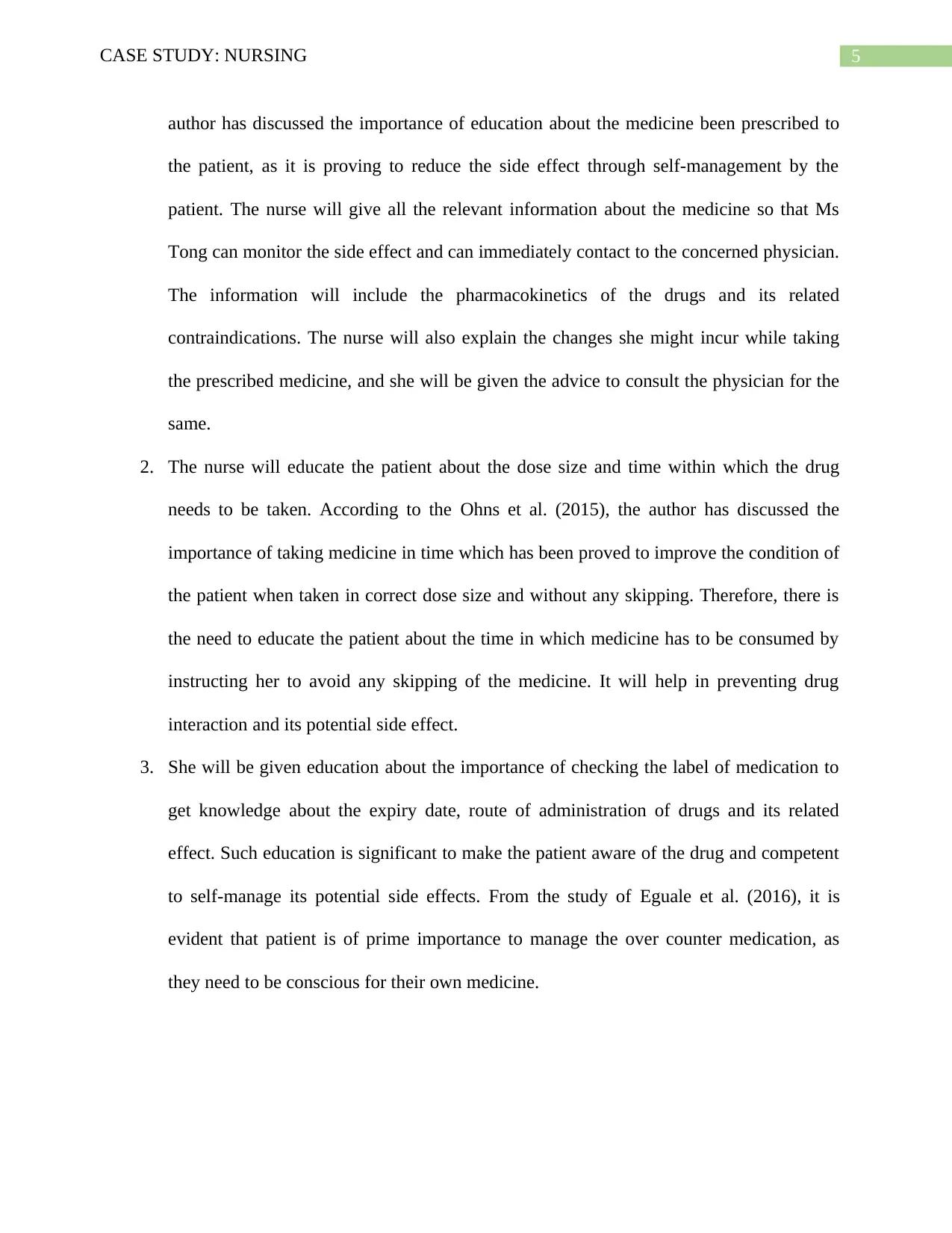
5CASE STUDY: NURSING
author has discussed the importance of education about the medicine been prescribed to
the patient, as it is proving to reduce the side effect through self-management by the
patient. The nurse will give all the relevant information about the medicine so that Ms
Tong can monitor the side effect and can immediately contact to the concerned physician.
The information will include the pharmacokinetics of the drugs and its related
contraindications. The nurse will also explain the changes she might incur while taking
the prescribed medicine, and she will be given the advice to consult the physician for the
same.
2. The nurse will educate the patient about the dose size and time within which the drug
needs to be taken. According to the Ohns et al. (2015), the author has discussed the
importance of taking medicine in time which has been proved to improve the condition of
the patient when taken in correct dose size and without any skipping. Therefore, there is
the need to educate the patient about the time in which medicine has to be consumed by
instructing her to avoid any skipping of the medicine. It will help in preventing drug
interaction and its potential side effect.
3. She will be given education about the importance of checking the label of medication to
get knowledge about the expiry date, route of administration of drugs and its related
effect. Such education is significant to make the patient aware of the drug and competent
to self-manage its potential side effects. From the study of Eguale et al. (2016), it is
evident that patient is of prime importance to manage the over counter medication, as
they need to be conscious for their own medicine.
author has discussed the importance of education about the medicine been prescribed to
the patient, as it is proving to reduce the side effect through self-management by the
patient. The nurse will give all the relevant information about the medicine so that Ms
Tong can monitor the side effect and can immediately contact to the concerned physician.
The information will include the pharmacokinetics of the drugs and its related
contraindications. The nurse will also explain the changes she might incur while taking
the prescribed medicine, and she will be given the advice to consult the physician for the
same.
2. The nurse will educate the patient about the dose size and time within which the drug
needs to be taken. According to the Ohns et al. (2015), the author has discussed the
importance of taking medicine in time which has been proved to improve the condition of
the patient when taken in correct dose size and without any skipping. Therefore, there is
the need to educate the patient about the time in which medicine has to be consumed by
instructing her to avoid any skipping of the medicine. It will help in preventing drug
interaction and its potential side effect.
3. She will be given education about the importance of checking the label of medication to
get knowledge about the expiry date, route of administration of drugs and its related
effect. Such education is significant to make the patient aware of the drug and competent
to self-manage its potential side effects. From the study of Eguale et al. (2016), it is
evident that patient is of prime importance to manage the over counter medication, as
they need to be conscious for their own medicine.
⊘ This is a preview!⊘
Do you want full access?
Subscribe today to unlock all pages.

Trusted by 1+ million students worldwide
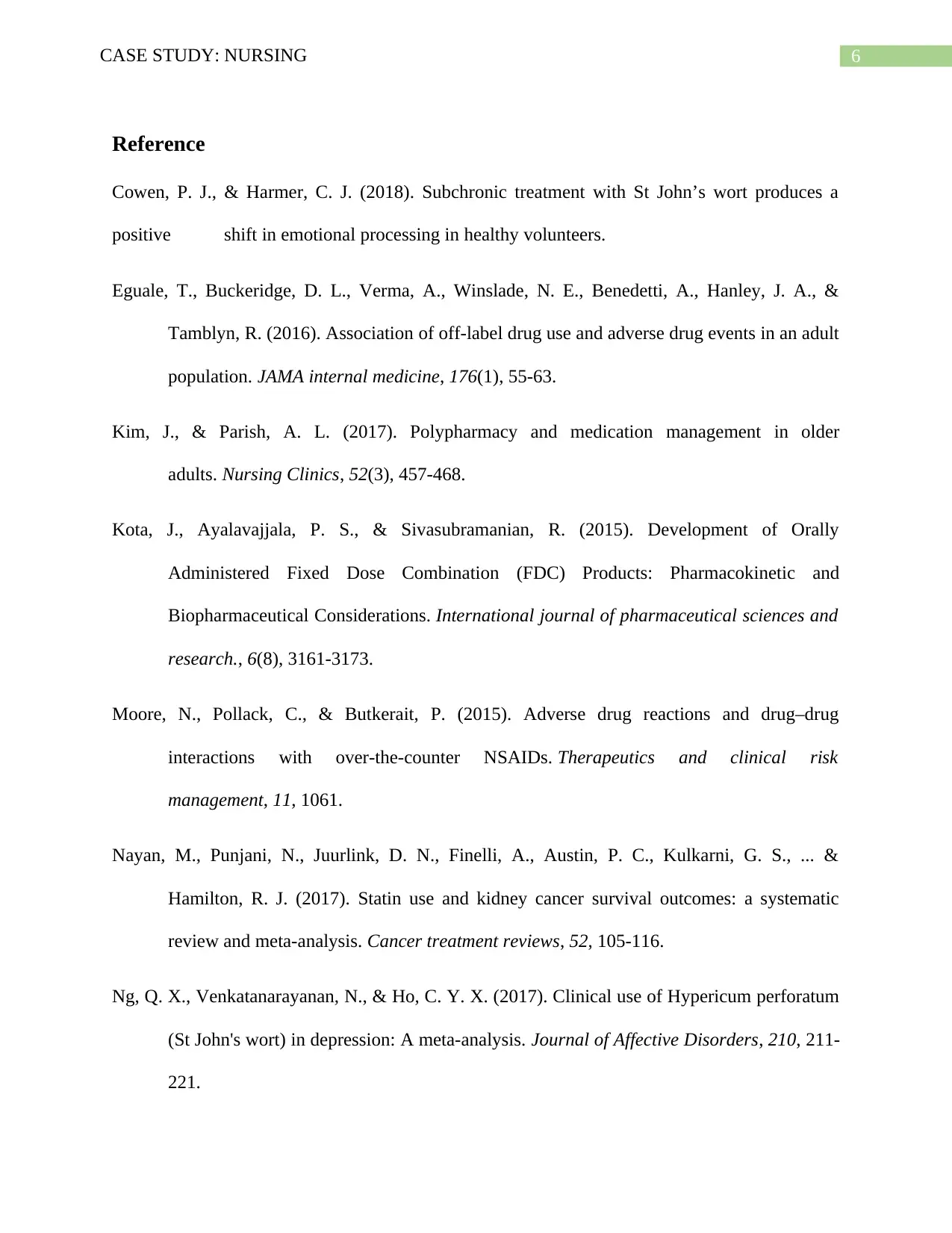
6CASE STUDY: NURSING
Reference
Cowen, P. J., & Harmer, C. J. (2018). Subchronic treatment with St John’s wort produces a
positive shift in emotional processing in healthy volunteers.
Eguale, T., Buckeridge, D. L., Verma, A., Winslade, N. E., Benedetti, A., Hanley, J. A., &
Tamblyn, R. (2016). Association of off-label drug use and adverse drug events in an adult
population. JAMA internal medicine, 176(1), 55-63.
Kim, J., & Parish, A. L. (2017). Polypharmacy and medication management in older
adults. Nursing Clinics, 52(3), 457-468.
Kota, J., Ayalavajjala, P. S., & Sivasubramanian, R. (2015). Development of Orally
Administered Fixed Dose Combination (FDC) Products: Pharmacokinetic and
Biopharmaceutical Considerations. International journal of pharmaceutical sciences and
research., 6(8), 3161-3173.
Moore, N., Pollack, C., & Butkerait, P. (2015). Adverse drug reactions and drug–drug
interactions with over-the-counter NSAIDs. Therapeutics and clinical risk
management, 11, 1061.
Nayan, M., Punjani, N., Juurlink, D. N., Finelli, A., Austin, P. C., Kulkarni, G. S., ... &
Hamilton, R. J. (2017). Statin use and kidney cancer survival outcomes: a systematic
review and meta-analysis. Cancer treatment reviews, 52, 105-116.
Ng, Q. X., Venkatanarayanan, N., & Ho, C. Y. X. (2017). Clinical use of Hypericum perforatum
(St John's wort) in depression: A meta-analysis. Journal of Affective Disorders, 210, 211-
221.
Reference
Cowen, P. J., & Harmer, C. J. (2018). Subchronic treatment with St John’s wort produces a
positive shift in emotional processing in healthy volunteers.
Eguale, T., Buckeridge, D. L., Verma, A., Winslade, N. E., Benedetti, A., Hanley, J. A., &
Tamblyn, R. (2016). Association of off-label drug use and adverse drug events in an adult
population. JAMA internal medicine, 176(1), 55-63.
Kim, J., & Parish, A. L. (2017). Polypharmacy and medication management in older
adults. Nursing Clinics, 52(3), 457-468.
Kota, J., Ayalavajjala, P. S., & Sivasubramanian, R. (2015). Development of Orally
Administered Fixed Dose Combination (FDC) Products: Pharmacokinetic and
Biopharmaceutical Considerations. International journal of pharmaceutical sciences and
research., 6(8), 3161-3173.
Moore, N., Pollack, C., & Butkerait, P. (2015). Adverse drug reactions and drug–drug
interactions with over-the-counter NSAIDs. Therapeutics and clinical risk
management, 11, 1061.
Nayan, M., Punjani, N., Juurlink, D. N., Finelli, A., Austin, P. C., Kulkarni, G. S., ... &
Hamilton, R. J. (2017). Statin use and kidney cancer survival outcomes: a systematic
review and meta-analysis. Cancer treatment reviews, 52, 105-116.
Ng, Q. X., Venkatanarayanan, N., & Ho, C. Y. X. (2017). Clinical use of Hypericum perforatum
(St John's wort) in depression: A meta-analysis. Journal of Affective Disorders, 210, 211-
221.
Paraphrase This Document
Need a fresh take? Get an instant paraphrase of this document with our AI Paraphraser

7CASE STUDY: NURSING
Ohns, M. J., Oliver-McNeil, S., Nantais-Smith, L. M., & George, N. M. (2016). Nonurgent use
of the emergency department by pediatric patients: A theory-guided approach for primary
and acute care pediatric nurse practitioners. Journal of pediatric health care, 30(4), 339-
346.
Psaty, B. M., Dekkers, O. M., & Cooper, R. S. (2018). Comparison of 2 treatment models:
precision medicine and preventive medicine. Jama, 320(8), 751-752.’
Rahikainen, A. L., Vauhkonen, P., Pett, H., Palo, J. U., Haukka, J., Ojanperä, I., ... & Sajantila,
A. (2019). Completed suicides of citalopram users—the role of CYP genotypes and
adverse drug interactions. International journal of legal medicine, 133(2), 353-363.
Kassi, M., McCallum, L., Muir, S., Touyz, R., Dominiczak, A. F., & Padmanabhan, S.
(2015). Abstract P153: Impact of Antibiotic Treatment on Antihypertensive Drug
Adherence. Hypertension, 66(suppl_1), AP153-AP153.
Sarkeshikian, S. S., Ghadir, M. R., Alemi, F., Jalali, S. M., Hormati, A., & Mohammadbeigi, A.
(2019). Atorvastatin in combination with conventional antimicrobial treatment of
Helicobacter pylori eradication: A randomized controlled clinical trial. Journal of
gastroenterology and hepatology.
Singh, R. K., Agarwal, V., Baronia, A. K., Kumar, S., Poddar, B., & Azim, A. (2017). The
effects of atorvastatin on inflammatory responses and mortality in septic shock: a single-
center, randomized controlled trial. Indian journal of critical care medicine: peer-
reviewed, official publication of Indian Society of Critical Care Medicine, 21(10), 646.
Ohns, M. J., Oliver-McNeil, S., Nantais-Smith, L. M., & George, N. M. (2016). Nonurgent use
of the emergency department by pediatric patients: A theory-guided approach for primary
and acute care pediatric nurse practitioners. Journal of pediatric health care, 30(4), 339-
346.
Psaty, B. M., Dekkers, O. M., & Cooper, R. S. (2018). Comparison of 2 treatment models:
precision medicine and preventive medicine. Jama, 320(8), 751-752.’
Rahikainen, A. L., Vauhkonen, P., Pett, H., Palo, J. U., Haukka, J., Ojanperä, I., ... & Sajantila,
A. (2019). Completed suicides of citalopram users—the role of CYP genotypes and
adverse drug interactions. International journal of legal medicine, 133(2), 353-363.
Kassi, M., McCallum, L., Muir, S., Touyz, R., Dominiczak, A. F., & Padmanabhan, S.
(2015). Abstract P153: Impact of Antibiotic Treatment on Antihypertensive Drug
Adherence. Hypertension, 66(suppl_1), AP153-AP153.
Sarkeshikian, S. S., Ghadir, M. R., Alemi, F., Jalali, S. M., Hormati, A., & Mohammadbeigi, A.
(2019). Atorvastatin in combination with conventional antimicrobial treatment of
Helicobacter pylori eradication: A randomized controlled clinical trial. Journal of
gastroenterology and hepatology.
Singh, R. K., Agarwal, V., Baronia, A. K., Kumar, S., Poddar, B., & Azim, A. (2017). The
effects of atorvastatin on inflammatory responses and mortality in septic shock: a single-
center, randomized controlled trial. Indian journal of critical care medicine: peer-
reviewed, official publication of Indian Society of Critical Care Medicine, 21(10), 646.
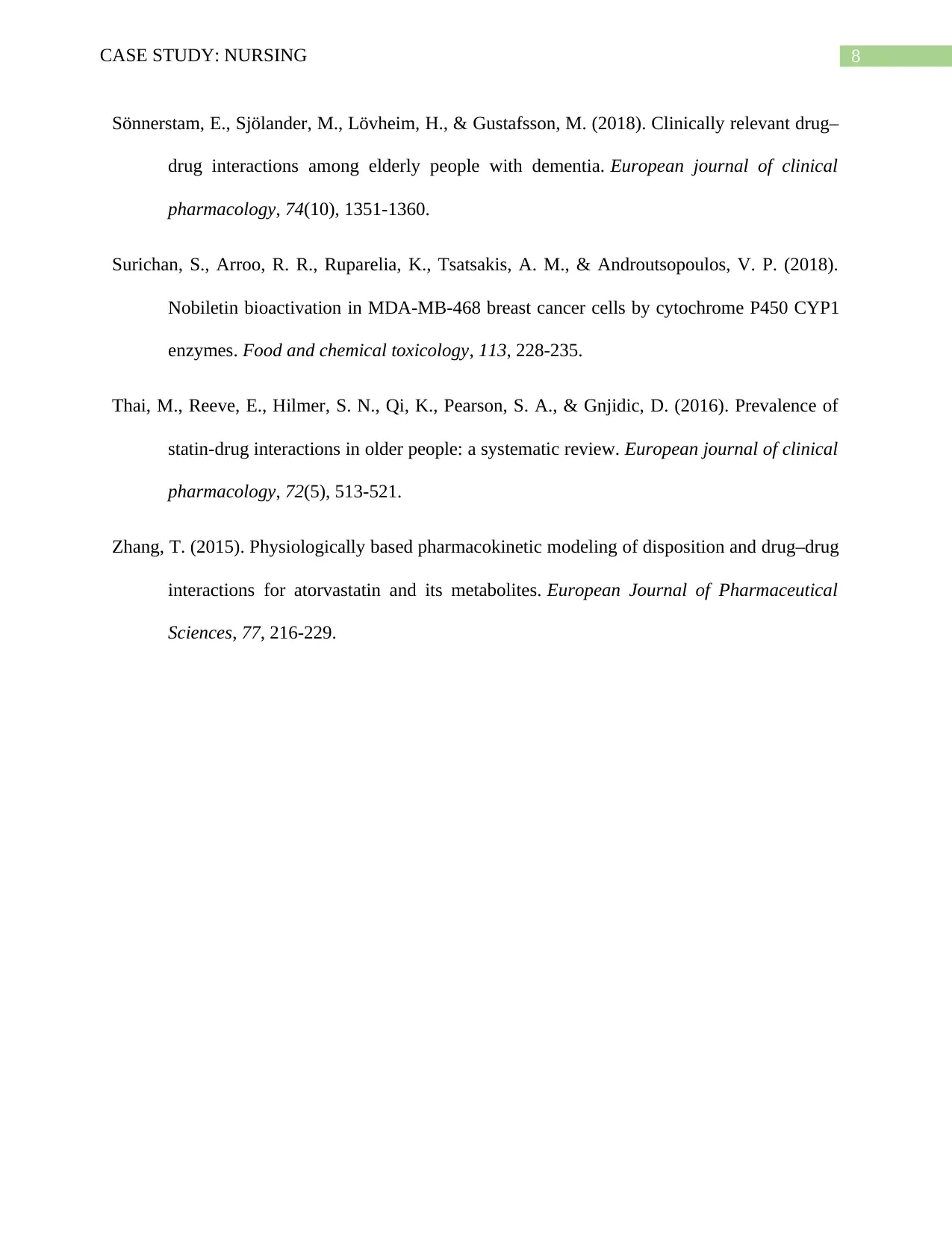
8CASE STUDY: NURSING
Sönnerstam, E., Sjölander, M., Lövheim, H., & Gustafsson, M. (2018). Clinically relevant drug–
drug interactions among elderly people with dementia. European journal of clinical
pharmacology, 74(10), 1351-1360.
Surichan, S., Arroo, R. R., Ruparelia, K., Tsatsakis, A. M., & Androutsopoulos, V. P. (2018).
Nobiletin bioactivation in MDA-MB-468 breast cancer cells by cytochrome P450 CYP1
enzymes. Food and chemical toxicology, 113, 228-235.
Thai, M., Reeve, E., Hilmer, S. N., Qi, K., Pearson, S. A., & Gnjidic, D. (2016). Prevalence of
statin-drug interactions in older people: a systematic review. European journal of clinical
pharmacology, 72(5), 513-521.
Zhang, T. (2015). Physiologically based pharmacokinetic modeling of disposition and drug–drug
interactions for atorvastatin and its metabolites. European Journal of Pharmaceutical
Sciences, 77, 216-229.
Sönnerstam, E., Sjölander, M., Lövheim, H., & Gustafsson, M. (2018). Clinically relevant drug–
drug interactions among elderly people with dementia. European journal of clinical
pharmacology, 74(10), 1351-1360.
Surichan, S., Arroo, R. R., Ruparelia, K., Tsatsakis, A. M., & Androutsopoulos, V. P. (2018).
Nobiletin bioactivation in MDA-MB-468 breast cancer cells by cytochrome P450 CYP1
enzymes. Food and chemical toxicology, 113, 228-235.
Thai, M., Reeve, E., Hilmer, S. N., Qi, K., Pearson, S. A., & Gnjidic, D. (2016). Prevalence of
statin-drug interactions in older people: a systematic review. European journal of clinical
pharmacology, 72(5), 513-521.
Zhang, T. (2015). Physiologically based pharmacokinetic modeling of disposition and drug–drug
interactions for atorvastatin and its metabolites. European Journal of Pharmaceutical
Sciences, 77, 216-229.
⊘ This is a preview!⊘
Do you want full access?
Subscribe today to unlock all pages.

Trusted by 1+ million students worldwide
1 out of 9
Related Documents
Your All-in-One AI-Powered Toolkit for Academic Success.
+13062052269
info@desklib.com
Available 24*7 on WhatsApp / Email
![[object Object]](/_next/static/media/star-bottom.7253800d.svg)
Unlock your academic potential
Copyright © 2020–2025 A2Z Services. All Rights Reserved. Developed and managed by ZUCOL.





